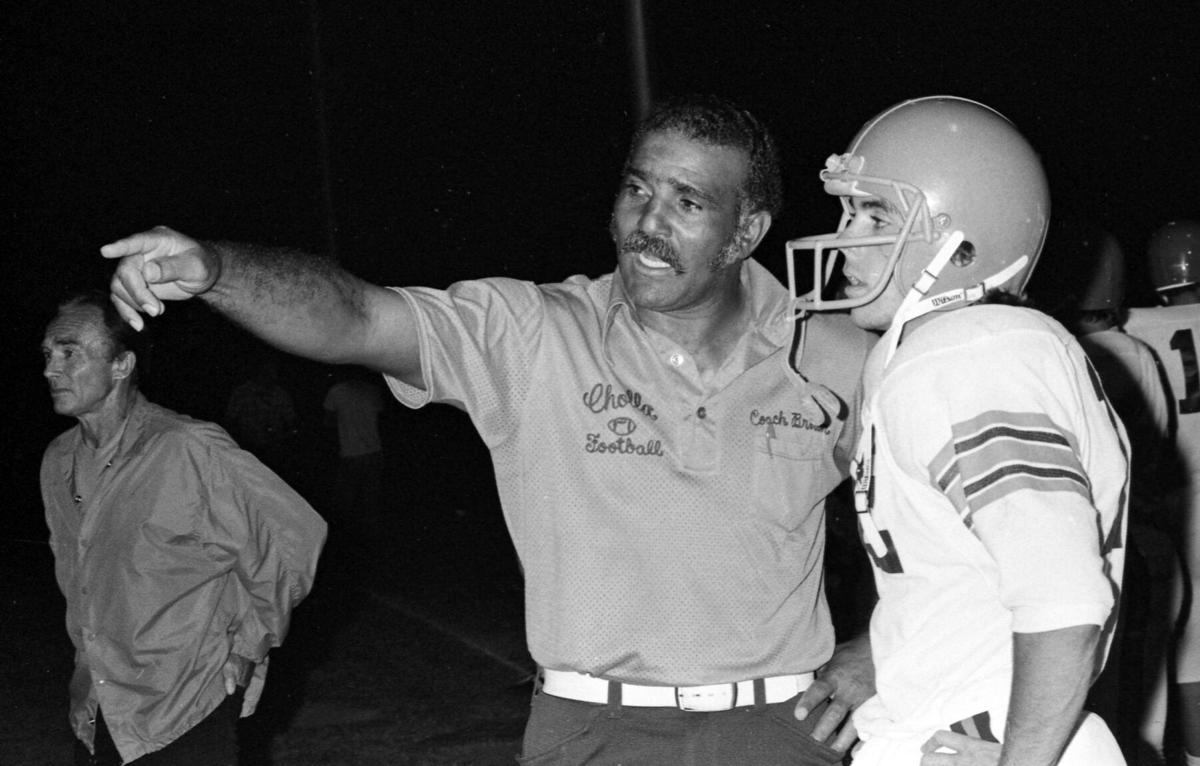Ed Brown was a Holy Terror, which is a good thing. He played for the Colorado Springs High School Holy Terrors — really — a dominant football player on the 1949 squad, a 6-foot, 200-pound linebacker. Brown, one of two Black players on the CSHS squad, said he was not recruited to play in college because of his race.
“Actually, I was recruited,” he told me before his induction to the UA Sports Hall of Fame in 1997. “I was recruited by the United States Marines.”
“He was quite an athlete,” his high school coach, Gib Funk, told the Colorado Springs Gazette in 1969. “Ed was a responsible young man. He was highly thought of by both the whites and his own people.”

As a two-way star at the UA, Ed Brown rarely came off the field.
That should give you an idea of what Edward Howard Brown had to overcome after he was born in segregated Eupora, Mississippi, in 1932, moving with his parents and six siblings to Colorado in 1943.
Brown, who is No. 20 on our list of Tucson’s Top 100 Sports Figures of the last 100 years, became so successful and so well respected that in the spring of 1969 Arizona athletic director Dick Clausen offered him a chance to be the first Black head coach at the major-college level. But Brown declined and instead became the head football coach at new Cholla High School.
He became the first Black head coach at a Tucson high school.
Brown’s road to the Pima County Sports Hall of Fame, Class of 1992, began while serving at the San Diego Marine Corps Recruiting Depot in the early 1950s. He became an all-service lineman, impressing his coach, Joe Stribling, so much that Stribling phoned his former coach at Hardin-Simmons University, Warren Woodson, who had just become the head coach at Arizona.
“Joe told me that Ed Brown could play for anybody, Notre Dame or USC, but that they weren’t recruiting him because he was (Black),” Woodson told me. “Well, that didn’t stop me. We only had one other Black player at Arizona, but Joe said Ed was the kind of guy who would be a team leader.”
Was he ever.
Brown started his first game as an Arizona freshman, in 1954, as well as all 40 games he played as a Wildcat. He rarely came off the field, playing guard and linebacker, becoming an All-Border Conference selection.
His main job was to clear a path for Art Luppino; the “Cactus Comet” would lead the NCAA in rushing in 1954 and 1955.
“You’d never see Ed sweat,” Luppino told me. “He was a leader under some difficult circumstances. I never met a better gentleman.”
Upon graduation, Brown was offered $7,000 to play for the Cleveland Browns but chose to stay in Tucson and pursue a more secure path as an educator. He was quickly hired by Pueblo High football coach Lou Farber, who made Brown his defensive coordinator. Together, Farber and Brown led Pueblo to the 1961 state championship and the 1967 state finals.

Ed Brown talks about coach Lou Farber during a memorial service for his longtime friend and colleague in 2002.
The union between Farber and Brown was so strong that when Cholla offered Brown its head coaching job in '69, Farber attempted to keep Brown at Pueblo.
“I would’ve stepped down and been Ed’s assistant if he wanted,” Farber told the Star. “He can coach at UA — they want him — but he wanted to work with youngsters.”

Coaching football at Cholla was one of the most difficult assignments in Southern Arizona prep football, then and now. Over 18 seasons, Brown’s Chargers went 91-98-2. The impact he made on young men was so strong that his record came off as more like 191-98-2. Upon his retirement, Cholla named its football facility Ed Brown Stadium.
“Besides my dad, Ed had the most influence in my life,” said Curly Santa Cruz, an all-city standout at Pueblo in the early '60s. “He’s a man of high character.”
Santa Cruz should know. He became a coaching rival of Brown’s and did so well that Pueblo’s football stadium is now named Curly Santa Cruz Stadium.
Brown retired from coaching in 1988. He died of leukemia in 2012.








